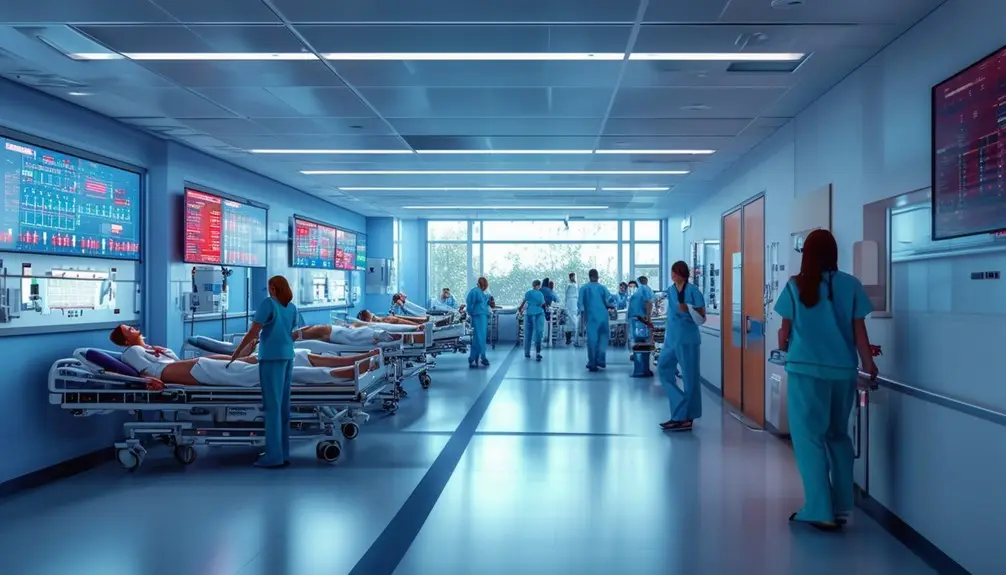Real-time emergency room status boards give you immediate access to patient statuses and operational metrics. These boards enhance situational awareness, support evidence-based practices, and streamline workflow efficiency. The integration of color-coded icons, real-time alerts, and patient deidentification guarantees both usability and patient privacy. Usability assessments show significant improvements in communication, reduced medical errors, and optimized patient coordination. Built on robust IT infrastructure, these boards maintain HIPAA compliance and provide vital insights into emergency room dynamics. You’ll also find that continuous iterations have made these tools indispensable for clinical decision-making. More in-depth insights into these features await.
Key Takeaways
- Real-time status boards provide immediate visibility into patient statuses, enhancing situational awareness in emergency departments.
- They integrate geographical layouts, icons, and color codes for clear and effective visual representation.
- Patient-level alerts notify staff of real-time changes, enabling timely interventions and improved patient outcomes.
- Status boards streamline workflow by delivering timely, accurate data that supports evidence-based clinical decision-making.
- They ensure patient privacy through deidentification and adherence to HIPAA regulations.
Development and Features
The real-time autonomous ED dashboard was meticulously developed to offer seamless, anytime, anywhere access for monitoring and managing the entire emergency department. This advanced system integrates several key features to enhance situational awareness and operational efficiency.
The dashboard leverages a geographical layout of the ED, providing a clear visual representation of patient locations and statuses. Through the use of icons and color codes, you can quickly identify patient conditions and critical areas requiring attention. Patient-level alerts further enhance responsiveness by notifying you of changes in patient conditions in real-time, ensuring timely interventions.
Real-time summary data is another critical feature, offering a snapshot of the ED’s activities and patient flow. This data aids in making informed decisions swiftly, optimizing patient care and resource allocation. Despite the level of detail provided, patient privacy is rigorously maintained. Information is deidentified and seamlessly integrated into the clinical workflow, ensuring compliance with privacy standards.
Usability evaluations using the System Usability Scale (SUS) and Situation Awareness Index (SAI) have indicated the dashboard’s high acceptability and effectiveness. These evaluations confirm that the system supports concentration and enhances the quality of information, making it an indispensable tool in emergency department management.
Evolution and Prototyping
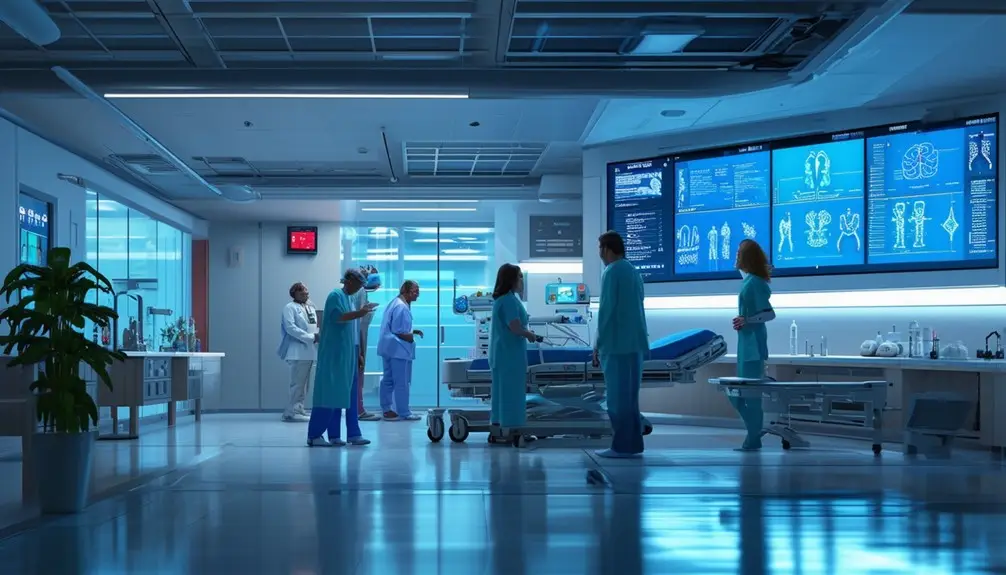
Over five years, iterative prototyping and structural renovations transformed the real-time emergency room status board, enhancing its usability and functionality. You see, the status board underwent three major revisions to improve usability, focusing on throughput factors and patient severity based on the conceptual model of ED crowding.
Prototyping efforts centered on selecting measures that directly supported clinical decision-making. By including output factors like boarding and discharge data, the dashboard provided crucial real-time insights. These improvements were essential in managing patient flow and resource allocation efficiently, particularly during high-stress periods such as the Middle East Respiratory Syndrome outbreak.
The technology behind the status board was robust, deployed on Windows servers and accessible across various devices within the emergency department. This guaranteed that healthcare providers could access real-time data seamlessly, enhancing overall operational efficiency.
Each iteration brought significant usability improvements, making the dashboard more intuitive and responsive to the needs of the clinical staff. The focus on real-time data and structural renovations adapted the system to evolving clinical environments, ensuring it remained a crucial tool for effective emergency room management. This iterative process underscored the importance of continuous prototyping in achieving a highly functional and user-friendly emergency room status board.
Usability Evaluation
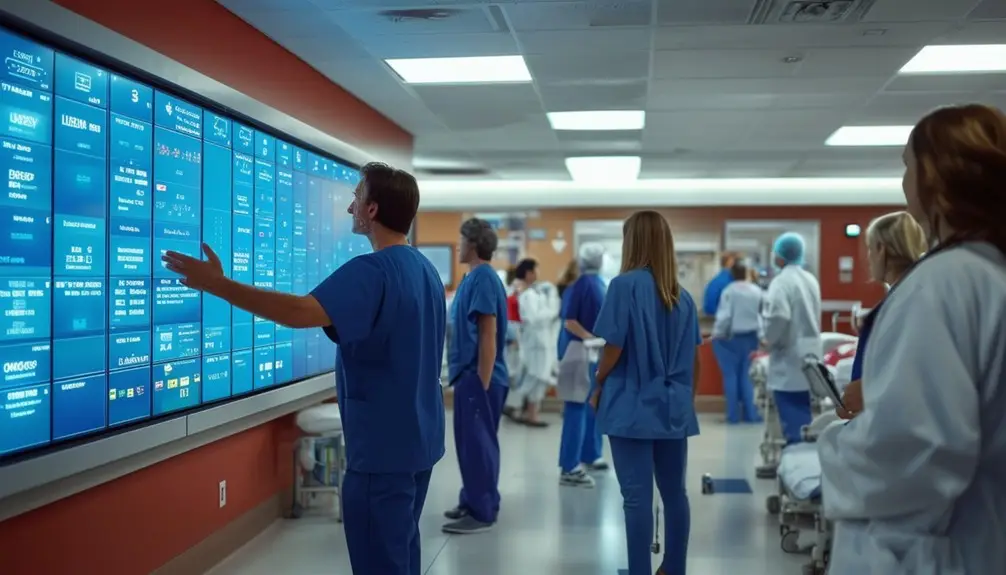
To evaluate usability, you’ll focus on key metrics such as the System Usability Scale (SUS) and Situation Awareness Index (SAI). Assess how staff interact with the dashboard and its impact on their workflow. Examine the quality of information delivery and its role in supporting clinical decisions.
Usability Metrics Assessment
When evaluating the usability metrics of the real-time ED dashboard, consider the System Usability Scale (SUS) score of 67.6, which indicates marginally high acceptability and usability. This score reflects the dashboard’s efficiency in enhancing real-time clinical decision-making support and information quality.
The Situation Awareness Index (SAI) further highlights the dashboard’s effectiveness, with a score of 3.87, demonstrating strong support for concentration and situational awareness. It’s remarkable that physicians rated the dashboard higher compared to nurses, suggesting differences in interaction levels.
Here’s a quick breakdown of key usability metrics:
| Metric | Score |
|---|---|
| SUS | 67.6 |
| SAI | 3.87 |
| Usability Rating | OK-to-Good |
Participants consistently reported the dashboard as easy to learn and use, requiring minimal technician support. This ease of use plays an essential role in improving workflow efficiency by expediting information delivery and augmenting clinical decision-making support. The feedback over the past five years has been overwhelmingly positive, underscoring the dashboard’s impact on enhancing situational awareness and supporting effective clinical decisions.
Staff Interaction Analysis
Evaluating staff interaction with the real-time emergency room status boards reveals crucial insights into their usability and impact on clinical workflows. The staff interaction analysis utilized usability evaluations, including the System Usability Scale (SUS) and Situation Awareness Index (SAI). The real-time status boards achieved an average SUS score of 67.6 points, demonstrating marginally high acceptability and usability among emergency room (ER) physicians and nurses. Additionally, the SAI score averaged 3.87 points, with physicians scoring higher than nurses, indicating that the boards effectively support concentration and information quality.
Participants noted several key benefits of the status boards:
- Easy to learn and use, requiring minimal technician support.
- Positive impact on workflow, aiding information delivery and clinical decision-making.
- Enhanced situational awareness for ER staff.
- Increased efficiency in patient management.
- Reduction in communication errors and delays.
These findings underscore the importance of usability evaluations in ensuring that technological tools like real-time status boards meet the practical needs of ER staff. By supporting situational awareness, these boards contribute significantly to the smooth functioning of emergency room operations. Continuous staff interaction analysis is essential for optimizing both user experience and clinical outcomes.
Information Delivery Quality
Information delivery quality in real-time emergency room status boards directly impacts the efficiency and effectiveness of clinical workflows. Usability evaluations using the System Usability Scale (SUS) and Situation Awareness Index (SAI) indicated that these boards scored an average of 67.6 points on the SUS. This score suggests moderately high acceptability and usability. Emergency department (ED) physicians and nurses found these boards easy to learn and use, requiring minimal technical support.
The real-time nature of these boards greatly enhances situational awareness, as evidenced by an SAI score of 3.87 points. Physicians scored higher than nurses on the SAI, demonstrating the boards’ effectiveness in aiding concentration and delivering high-quality information. These boards are instrumental in streamlining workflow by providing timely and accurate data, which is essential for effective clinical decision-making.
Clinical Benefits
You’ll find that real-time emergency room status boards greatly enhance decision-making by providing immediate access to patient data. They reduce medical errors through accurate, up-to-the-minute information. Improved patient coordination is achieved as these boards facilitate seamless communication among healthcare teams.
Enhanced Decision Making
Real-time emergency room status boards greatly enhance clinical decision-making by providing healthcare professionals with immediate access to critical patient and departmental data. This real-time access to patient information enables you to make informed decisions swiftly, which is crucial in emergency care settings. The boards’ visualizations help you recognize bottlenecks, monitor adherence to time goals, and improve overall workflow efficiency.
These boards offer:
- Immediate visibility into patient statuses
- Enhanced situational awareness
- Support for evidence-based practices
- Identification of workflow inefficiencies
- User-centered design for best usability
By displaying at-a-glance access to patient processes and department performance, status boards assist in identifying areas requiring immediate attention. This enhanced situational awareness supports critical clinical decision-making by ensuring you’re always informed about patient conditions and resource availability. The user-centered design ensures that the boards are intuitive and effective, allowing you to focus on patient care rather than navigating complex systems.
Incorporating these real-time status boards into emergency care facilities has shown to greatly improve clinical outcomes. By streamlining processes and enhancing workflow efficiency, these tools empower you to deliver faster, more accurate care, thereby raising the standard of emergency medicine.
Reduced Medical Errors
Implementing real-time emergency room status boards greatly reduces the occurrence of medical errors by enhancing communication and coordination among healthcare staff. These boards facilitate immediate access to critical patient information, allowing for accurate and timely clinical decisions. With real-time data at your fingertips, the likelihood of errors in treatment or medication administration decreases significantly.
By providing an up-to-the-minute overview of patient statuses and department flow, these boards guarantee that every team member is on the same page. This seamless communication is pivotal for patient safety, as it mitigates the risk of miscommunication and lost information.
| Category | Benefit |
|---|---|
| Patient Information | Quick access to precise data |
| Real-Time Data | Immediate updates on patient status |
| Communication | Enhanced coordination among staff |
| Patient Safety | Reduced medical errors |
Enhanced coordination among healthcare teams leads to a streamlined workflow and more efficient task management. This systematic approach not only minimizes medical errors but also enhances overall patient safety. When healthcare providers can rely on real-time data, they can act promptly and accurately, securing the best possible outcomes for their patients.
Improved Patient Coordination
Emergency room status boards streamline patient coordination by delivering real-time updates that enhance both communication and workflow efficiency. In emergency care settings, having immediate access to real-time data is essential. These boards provide up-to-date information on patient statuses, enabling healthcare staff to coordinate more effectively. By improving patient coordination, you can see a direct impact on patient outcomes and overall satisfaction.
With real-time data at your fingertips, you can quickly identify and address any bottlenecks, guaranteeing an efficient workflow. This visibility allows for more informed decision-making and timely goal adherence, which is crucial in emergency care settings. Improved coordination among healthcare teams leads to better task management and reduces the likelihood of medical errors.
Here are some key benefits of using real-time emergency room status boards:
- Enhanced Communication: Facilitates quick information sharing among healthcare staff.
- Efficient Workflow: Streamlines processes, reducing delays and improving patient care.
- Timely Updates: Provides immediate status changes, aiding in rapid response.
- Better Task Management: Helps prioritize tasks based on current patient needs.
- Increased Patient Satisfaction: Ensures patients receive timely and appropriate care.
HIPAA Compliance
Ensuring HIPAA compliance, waiting room displays in healthcare settings use non-identifiable markers like random numbers or icons to maintain patient confidentiality. This approach safeguards patient privacy by eliminating the use of names or other identifying information. HIPAA compliance is pivotal in healthcare settings to protect sensitive patient data from unauthorized access.
Patient confidentiality is maintained through these innovative methods, allowing patients and their families to stay informed without compromising privacy. Real-time updates on these displays provide essential information about patient status, reducing anxiety and frustration for those waiting. These updates are designed to be immediate and accurate, ensuring that patients and their loved ones receive timely information while still adhering to strict privacy regulations.
Custom Displays
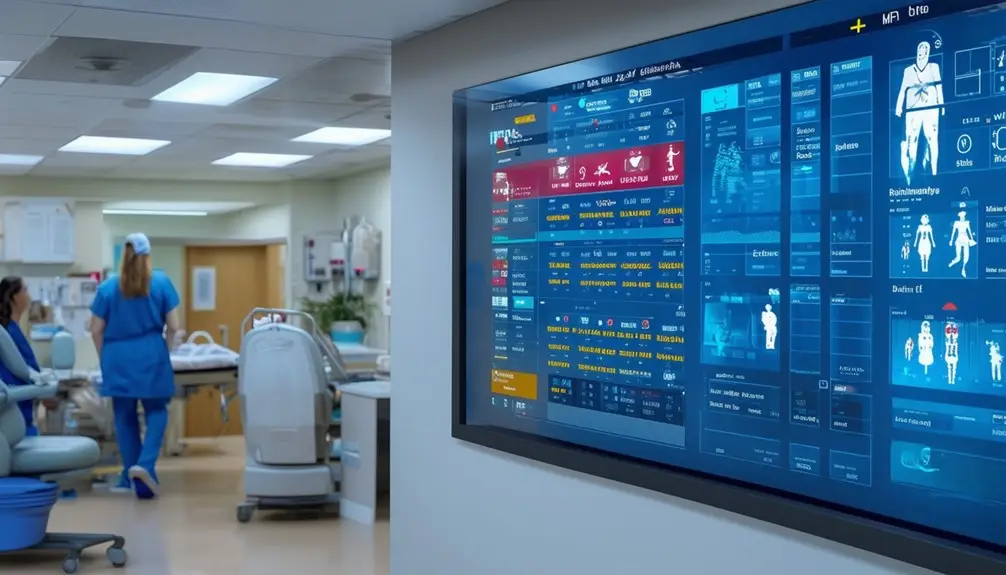
Custom displays for emergency room status boards offer tailored solutions that enhance patient confidentiality and streamline communication. By using custom displays, you can separate patients by healthcare provider and utilize color-coded statuses for easy identification. This approach guarantees that only authorized personnel can access sensitive information while maintaining an efficient workflow.
To further protect patient confidentiality, custom displays can represent patient information with randomly assigned numbers, words, or pictures. This method minimizes the risk of unauthorized access to personal details. Additionally, waiting room displays can be designed to cater to specific settings, such as small medical clinics or children’s hospitals, using fun characters for patient identification.
Here are some key features of custom displays:
- Color-coded statuses: Easily track patient progress and priority levels.
- Healthcare provider separation: Assign patients to specific providers for organized care.
- Random identifiers: Use numbers, words, or pictures to safeguard patient information.
- Tailored settings: Customize displays for various healthcare environments, including specialized clinics.
- Enhanced waiting room displays: Improve patient experience and communication through clear, engaging visuals.
Patient Communication
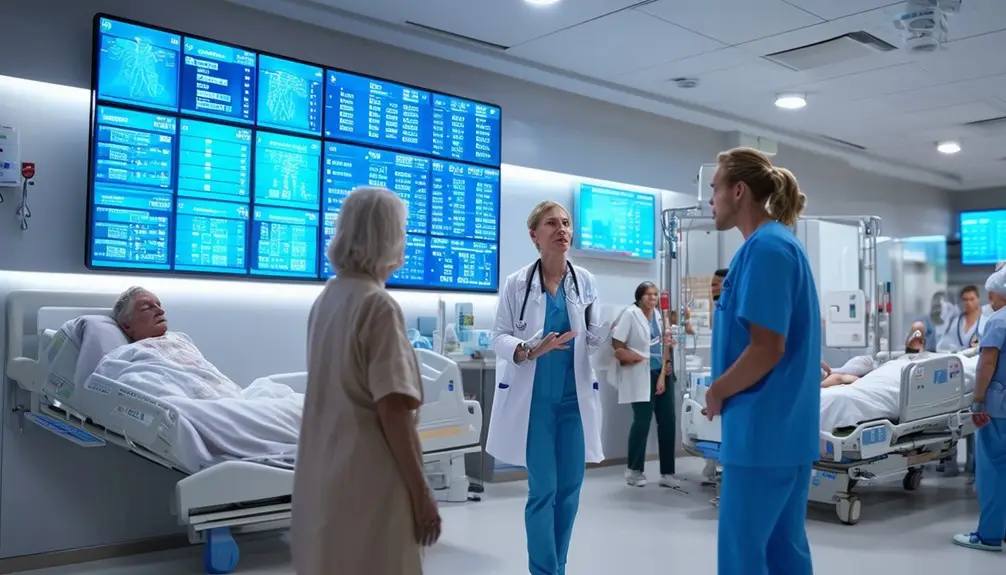
Building on the benefits of custom displays, patient communication via real-time emergency room status boards guarantees timely updates on waiting times, treatment progress, and next steps. These boards employ patient identification methods like random numbers, words, or image icons to safeguard privacy while ensuring clarity. By providing real-time updates, they effectively reduce patient anxiety and frustration, particularly in high-stress waiting room environments.
Communication features on these waiting room displays are designed to keep patients and their families informed at all times. You’ll notice that the constant flow of updates greatly enhances the patient experience. Not only do they keep you informed, but they also streamline the registration process, mitigating the uncertainty often associated with emergency room visits.
These meticulously designed systems guarantee that you’re never left in the dark about your status or the next steps in your treatment journey. The real-time updates on waiting room displays foster a sense of transparency and trust. This thorough approach to patient communication not only boosts overall satisfaction but also contributes to a more efficient and responsive emergency room environment. The result? An improved patient experience that prioritizes your need for timely and accurate information.
Future Developments
Future developments in real-time emergency room status boards will leverage artificial intelligence to enhance personalized patient care and improve overall efficiency. By integrating AI, these systems will analyze patient data in real-time, offering tailored recommendations and optimizing treatment plans. This innovation promises to transform emergency medicine by streamlining processes and supporting evidence-based practices.
You’ll see several key advancements in this area:
- AI-Powered Diagnostics: Real-time analytics will assist in quicker, more accurate diagnoses.
- Predictive Analytics: Anticipate patient needs and resource allocation to enhance workflow management.
- Personalized Alerts: Customizable notifications for healthcare providers based on individual patient conditions.
- Integrated Communication Tools: Seamless communication between departments to ensure a cohesive care approach.
- Data-Driven Insights: Continuous improvement through the analysis of treatment outcomes and operational efficiency.
These innovations aim to improve patient outcomes and reduce wait times. Collaboration with industry partners will be essential for driving these advancements. The expansion of computerized systems in healthcare settings will further enhance patient care by making information readily available and actionable. As these technologies evolve, emergency rooms will become more adept at handling patient influxes, making sure that care is both timely and effective.
Conclusion
Imagine the emergency room as a bustling train station. Real-time status boards act as the conductors, directing traffic, ensuring smooth operations, and keeping everyone informed. Their development, usability, and clinical benefits are well-documented, providing a seamless, efficient patient experience. Custom displays cater to specific needs while maintaining HIPAA compliance. As technology evolves, these boards will only become more integral, enhancing communication and patient care. Stay on track with these advancements for a future of improved emergency services.
Frequently Asked Questions
How do real-time emergency room status boards benefit patients and staff?
These boards provide several advantages: they provide patients with realistic expectations regarding wait times, enable staff to efficiently manage patient flow and resources, enhance communication among different emergency room departments, aid in prioritizing urgent cases, alleviate patient anxiety and complaints related to extended waits, and allow hospital management to monitor emergency room performance in real-time.
Are real-time emergency room status boards connected to other hospital systems?
Yes, these boards are usually connected with the hospital’s electronic health record (EHR) system, patient tracking software, bed management systems, triage assessment tools, and hospital-wide communication networks to ensure seamless updates and efficient patient management across various departments and care settings.

